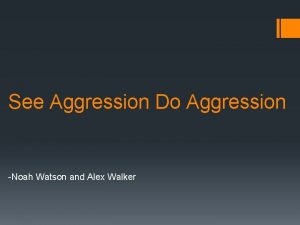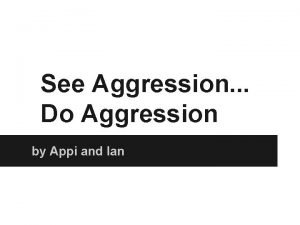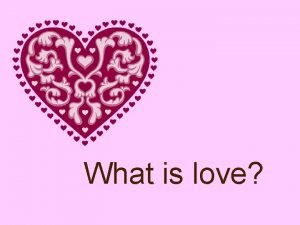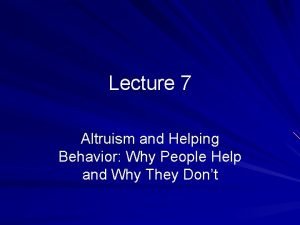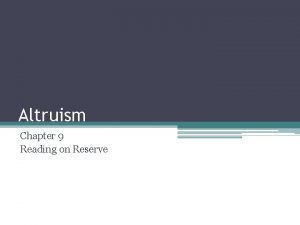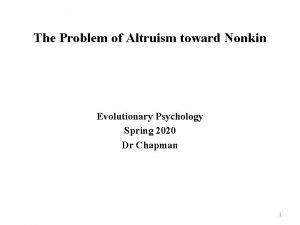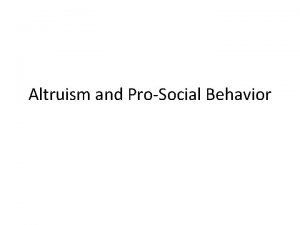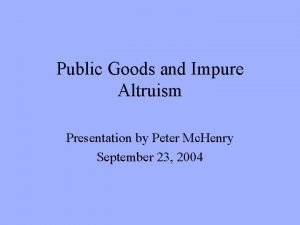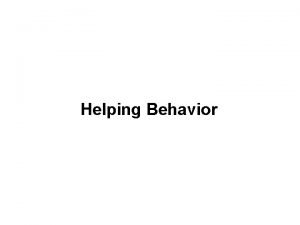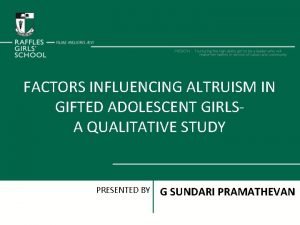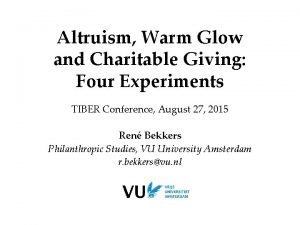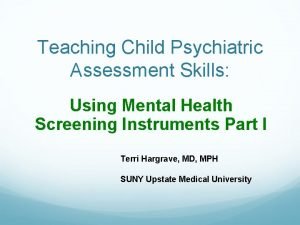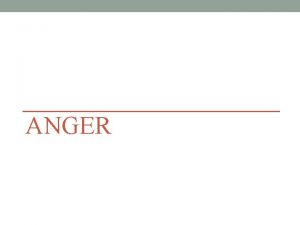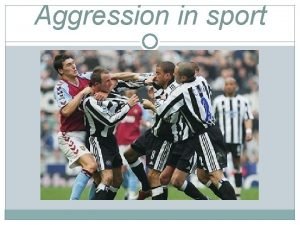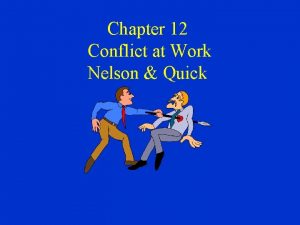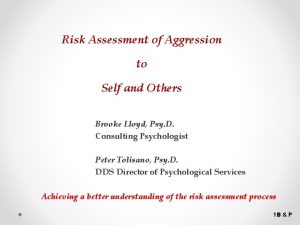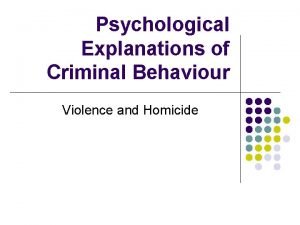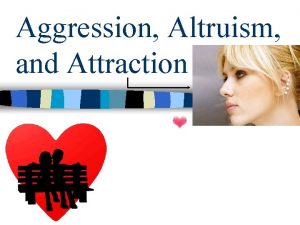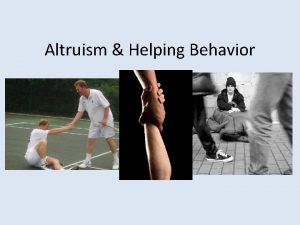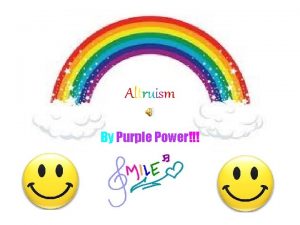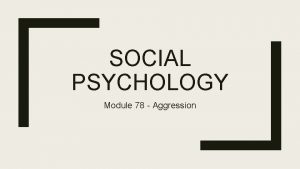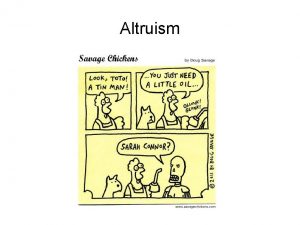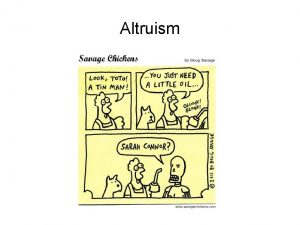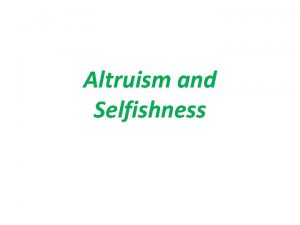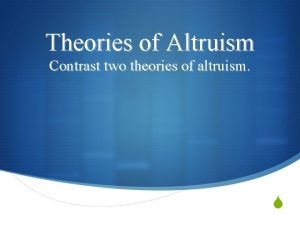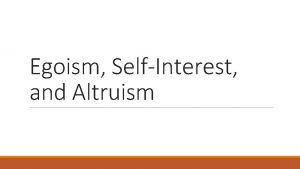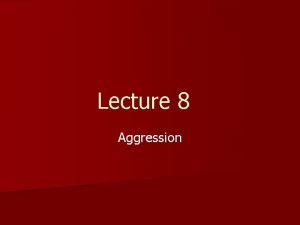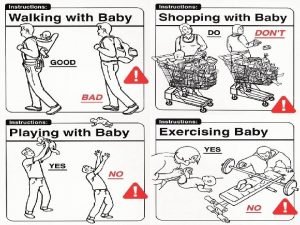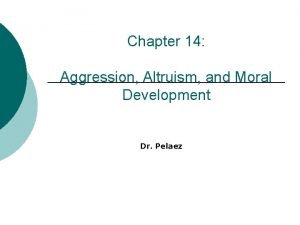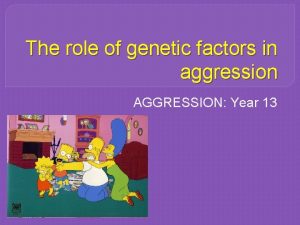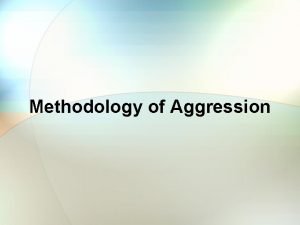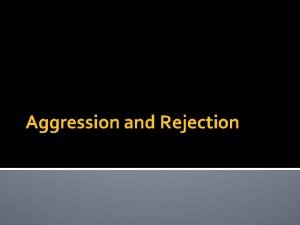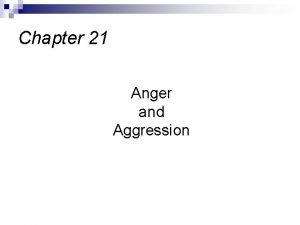Lecture 8 Aggression Altruism n n n 1






















- Slides: 22

Lecture 8 Aggression

Altruism n n n 1. Critical Issue: Whey people don’t help. 2. Philisophical Issue: Are we good or evil? 3. Research: Causes of helping behavior 4. Control: How to increase helping. Aggression n n n 1. Critical Issue: Intraspecies Aggression 2. Philisophical Issue: Are we good or evil? 3. Research: Causes of aggression 4. Control: How to decrease aggression.

I. Defining Aggression n According to text, it is a behavior whose goal is the injury of the person toward whom it is directed. n Ok, but not so easy (as discussed in class)

II. Instinct Theories of Aggression n A. Lorenz and other functional ethologists. n 1. Aggression is a series of preprogrammed responses similar to imprinting (i. e. , instinctual bonding of newborns with mothers) n a. imprinting is a series of fixed action patterns, the closer the object is to a hen, the greater the bonding between chick and object.


Konrad Lorenz and His Goslings

n b. there are many other fixed action patterns, e. g. , geico-geico bird, ground wasps, those darn starlings in my fireplace. n c. Aggression then, is seen as the release of a fixed action pattern towards a specific target.

ASE (attack) FAP IRM (stimuli) IM Action Specific Energy (ASE) or in this case attack energy builds up Until an appropriate Innate Releasing Mechanism (IRM) or stimuli (e. g. , Robin’s red breast, Black-bird’s red wings) Comes along and blocks the Inhibitory Mechanism (IM), releasing the Fixed Action Pattern FAP) for Attack

n 2. Build-up of ASE can override IM. n E. g. , Lorenz (1963) Male tropical fish n Male tropical fish other male fish of same species n If no males other fish of different species n If only females of same species the male will attack them eventually

n n n 3. Monkeys and Humans: facial expressions? 4. Releasing ASE in humans? Lorenz says sports is the answer. 5. Human aggression: a. Lorenz thought humans only mammal to systematically kill other members of own species. b. Not true, but we are very aggressive, other animals often have stronger inhibitions. c. This is due to: 1). Weak inhibitions 2). Weapons d. Descriptive evidence: distance, psuedospeciation e. Lab evidence: Milgram experiment on obedience and distance And Zimbardo experiment on anonymity and electric shocks.

B. Freud n n n n 1. Eros vs. Thanatos 2. Eros (life force)-love, sex, procreation Topology: Id = sexual energy or libido, the Id wants Ego = the reality principle, it gets E. g. Self, Others, Chicken, Cow Superego = preconscious, it often inhibits E. g. Self No!, Other Maybe, Others No!, Chicken No!, Cow Hmm.

n 3. Thanatos (death force) –hate, death wish, aggression turned outward n Id, Ego and Superego work same way but for aggression. n Note similarity between id, ego, and superego and ASE, IRM, and IM n Both Freud and Lorenz were catharsis theorists; aggressive energy will build until released either through sports or displaced aggression.

III. Learning Theories (from some instinct to none) n n n n A. Frustration-Aggression Hypothesis (Dollard & Miller): Frustration always leads to aggression and aggression always presupposes frustration. 1. Problem? 2. Modified hypothesis: Frustration may lead to aggression, but aggression always presupposes frustration. 3. Research: Hovland & Sears (1943) –lynchings and the price of cotton; Miller & Bulgelski (1938)— prejudice and frustration. 4. Other Problems a. etiology: biological or learned? b. lab studies show that aggression not only response to frustration (e. g. , Myers and experimental neurosis: rats, cows, and sheep freeze, attempt to escape, cry, and show overall disintegration of behavior.

n B. Berkowitz’s Cue Theory n 1. Brings back biological component. Frustration leads to anger, anger leads to a readiness for aggression. n 2. Aggression will occur if there are cues for aggression in the situation or from past situations. n 3. Research

a) Berkowitz & Le. Page: mean # of shocks given as a function of anger and cue value Not angered Angered Toy Gun 2. 40 5. 87 Raquet ------ 4. 60 None 3. 07 4. 67 Cue

b) Berkowitz’s “Kirk” study: # of shocks given after being angered or not and watching Kirk Douglas get beaten up on the film, “The Champion” or not Aggressive Film n Angered Not Angered n Kirk Bob n 6. 09 4. 53 1. 73 1. 45 n Neutral Film Angered Not Angered Kirk Bob 4. 18 4. 00 1. 54 1. 64

n c) What is the problem with these studies? n d) What is the solution? n Geen-arcades, Boyanowski- RCMP, Car & Gun study. n e. Road rage? – have peaceful signs or cues.

n C. Zillman’s Excitation Transfer Theory n 1. Stolen from Schachter’s Two-factor theory of emotion: Arousal Leads to Cue seeking in order to label emotion. Cues lead to specific emotion (e. g. , Schachter & Singer study: When aroused we take on the emotion of the confederate, crying or laughing). 2. When we aroused either through frustration, sex, or whatever, and there is a cue in the environment, we will aggress. 3. What Zillman doesn’t stress and the book doesn’t mention, is that frustration can also lead to helping behavior (e. g. , Davitz and frustrated children watching film). 4. Theory accounts for both aggression and helping 5. Application: Arousal and the Canadian Kidnapping Crisis. (Sorrentino, Vidmar, & Goodstadt, 1972). Also: Remember Pearl Harbor, Remember the Maine, Tonkin Gulf and the Viet Nam War. n n

D. Social Learning Theory (Bandura and Walters) n A. Most Popular Theory (especially if you are opposed to violence on TV or in the Movies). n B. Basic Tenet: Learning can occur without reinforcement, simple modeling will result in imitation. n C. Classic Study by Bandura (1965) on learning verus performance:

Bandura (1965). Mean number of hits after observing model hit Bobo doll and being rewarded, punished, or no consequences

Mean Number of hits After children are told they will receive a reward for doing what the model did

n Bandura study shows that learning takes place without direct reinforcement, but note that watching the aggressor punished reduced imitation as reward increases it. n Note also that the measure of aggression here is beating up on a Bobo doll.
 See aggression do aggression
See aggression do aggression See aggression do aggression
See aggression do aggression Greek words for love
Greek words for love Cha chonbi's altruism
Cha chonbi's altruism Altruism theory
Altruism theory Altruism molly peacock
Altruism molly peacock Reciprocal altruism theory
Reciprocal altruism theory What is altruism
What is altruism Altruism theory
Altruism theory Deindividuation
Deindividuation Pure altruism
Pure altruism Empathetic altruism
Empathetic altruism Conclusion of exceptional child
Conclusion of exceptional child Social trap psychology definition
Social trap psychology definition Warm glow altruism
Warm glow altruism 01:640:244 lecture notes - lecture 15: plat, idah, farad
01:640:244 lecture notes - lecture 15: plat, idah, farad Modified overt aggression scale score interpretation
Modified overt aggression scale score interpretation Anger vs aggression
Anger vs aggression Instrumental aggression
Instrumental aggression Aggression defence mechanism
Aggression defence mechanism Aggression risk assessment
Aggression risk assessment German aggression september 1938
German aggression september 1938 Hcr-20
Hcr-20
